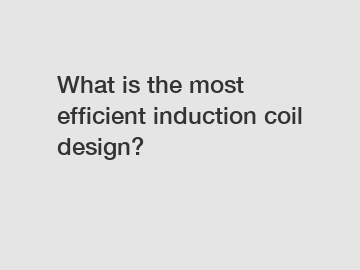Feb. 12, 2024
Machinery
TY-induction are exported all over the world and different industries with quality first. Our belief is to provide our customers with more and better high value-added products. Let's create a better future together.
Induction coils are indispensable components in a wide range of applications, from power transmission and medical devices to metal heating processes. As industries strive for enhanced efficiency, it becomes imperative to explore the most effective induction coil design. In this blog, we will embark on a journey to uncover the secrets behind the most efficient induction coil design and delve into the factors that contribute to its effectiveness.
1. The Importance of Efficient Induction Coil Design:

Efficiency plays a vital role in minimizing power loss and maximizing output in any technological system. Similarly, an efficient induction coil design ensures optimal energy transfer, reduced heat dissipation, and enhanced productivity. By developing a coil design that minimizes energy losses and maximizes magnetic field generation, we can revolutionize the performance of various induction-based applications.
2. Factors Influencing Induction Coil Efficiency:
a. Geometrical Design:
The geometrical characteristics of an induction coil greatly impact its efficiency. By meticulously fine-tuning parameters like the number of turns, wire diameter, and coil shape, we can optimize its performance. Different coil shapes, such as flat, toroidal, or helical, can dramatically affect the coupling efficiency with the magnetic field, resulting in varying degrees of energy transfer and heat generation.
b. Magnetic Core Materials:
Selecting the right magnetic core material is crucial for achieving high efficiency. Materials like ferrite, powdered iron, and laminated steel cores possess excellent magnetic properties and minimize energy loss through their superior permeability. By carefully considering the core material's saturation characteristics, hysteresis losses, and eddy current losses, we can design coils with exceptional performance.
c. Cooling Mechanisms:
Efficient cooling is essential to prevent excessive heat generation during high-power applications. Incorporating effective cooling mechanisms, such as liquid or air cooling, helps maintain optimal operating temperatures and minimizes energy loss due to resistive heating. Heat dissipation techniques, like using cooling fins or forced air circulation, enable the coil to operate at higher power levels without compromising efficiency.
3. Innovative Design Approaches:
To push the boundaries of induction coil efficiency, designers and engineers continually explore innovative approaches. Some noteworthy advancements include:
a. Multi-Layered Coil Designs:
By incorporating multiple layers of wire windings, we can optimize the coil's magnetic field coupling and enhance energy transfer efficiency. This design allows for better heat dissipation, reducing hotspots and ensuring more uniform temperature distribution.
b. Active Magnetic Cooling:
Active magnetic cooling involves incorporating magnetic fluid in the coil system. The fluid undergoes phase changes due to magnetic induction, cooling the coil without the need for external cooling mechanisms. This approach enables efficient heat removal while maximizing energy transfer.
4. The Role of Advanced Simulation Tools:
Advanced simulation tools and software have revolutionized the way induction coil designs are optimized. Finite element analysis (FEA) and computational fluid dynamics (CFD) facilitate accurate prediction of coil performance under varying conditions, enabling iterative design improvements. By incorporating data-driven insights and simulating multiple scenarios, engineers can fine-tune coil geometries for optimal performance, potentially achieving unparalleled efficiency.
5. Case Study: Automotive Induction Heating Systems.
An area where the quest for optimal efficiency is particularly relevant is the automotive industry. Induction heating systems, used for processes like heat treating, shrink-fitting, and surface hardening, demand highly efficient coil designs. Through continuous research and experimentation, automotive manufacturers have significantly improved induction coil efficiency, thereby reducing energy consumption and process time.
Conclusion:
In conclusion, the quest for the most efficient induction coil design is an exciting journey that combines science, engineering, creativity, and innovation. By considering factors such as geometrical design, core materials, cooling mechanisms, and leveraging advanced simulation tools, we can continuously push the boundaries of performance. Achieving high efficiency in induction coils not only enhances power transfer but also contributes to sustainability by minimizing power wastage. As technology progresses, we can anticipate even more breakthroughs in coil design, leading to revolutionary advancements across diverse industries.
If you are looking for more details, kindly visit our website.
For more information, please visit hardening machines.
Previous: Which New Pallet Fork Frame Design Reigns Supreme?
Next: Which Multihead Weigher for Sale offers the best value for money?
If you are interested in sending in a Guest Blogger Submission,welcome to write for us!
All Comments ( 0 )